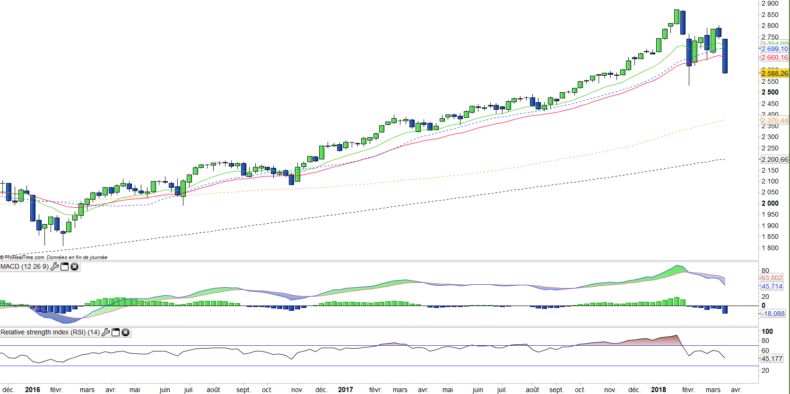SPDR S&P 500 (SPY) - 26/03/2018
Short Term strategy: Negative (20%) / Trend -
Long Term strategy: Positive (90%) / Trend -
Characteristics of the ETF
The SPY ETF (SPDR) created in 01/1993 replicates the S & P 500 index, which is composed of the 500 main US stocks representative of the main sectors, while the stocks are selected according to the size of their market capitalization.
The ETF fees are quite low at 0.0945% and the AUM is $ 263bn. Replication is direct (physical) and there is a dividend distribution policy on a quarterly basis.
Alternative ETFs: AUM5 (Amundi in Euro), SP5 (Lyxor in Euro), IVV (iShares, in USD)
Latest developments
After a rise of 19.4% in 2017, and a sharp rise in January (+ 5.6%), the S & P500 suffered a sharp correction phase in February, then relapsed sharply after a few weeks of rebound and posted now a decrease of 3.2% since the beginning of the year.
The relapse is due to the new protectionist actions decided by D.Trump against China that target an amount of 60md of exports, the latter has retaliated to a certain extent by targeting only 3md $ of US exports but the negative cycle of actions / retaliation is triggered.
The other worrying news is the appointment of John Bolton - known for his positions in favor of preventive wars against Iran and North Korea - as a security adviser to D.Trump, which should revive international tensions and make the future even more uncertain, particularly with regard to relations with Iran, which threatens to resume its nuclear program in the event of a US withdrawal from the agreement that could come as early as May.
Index & components
The top 10 stocks of the S&P500 include five major technology stocks (Apple, Amazon, Microsoft, Alphabet and Facebook), but also larger, more classic and iconic American companies such as JP Morgan or Exxon Mobil.
The main advantage of this index is its depth, which allows it to be a good proxy for the US economy, with a sector weighting that favors the growth sectors a little more, just like the technology stocks that represent about 25% of the weighting. Financials account for just under 15% of the index, and energy values of 6% are well balanced by defensive sectors such as health (about 14%) and consumer discretionary (13%).
The index has benefited from a strong momentum since the election of D. Trump, more than a year ago, while alongside the technology that remains the engine of the US market, new sectors have joined the trend, however a correction is now underway on the index because of fears of a return of inflation following the program of lower taxes for US businesses and households that should have a positive impact on growth, while announced deregulation on shale oil and banks could also benefit these sectors.
However the multiples of the S&P 500 are currently quite high, even after the ongoing correction at around 19x the results at 12 months, which is at the top of range (historically between 15 and 20x) even if it must be put in American economy growth estimated at around 3% in 2018. The whole question is now about the duration of the US cycle in a context of rising rates which is still progressive for the moment while the level of margins companies is at its highest level and seems to have lost much upside potential, even though the consensus is again on double-digit earnings growth in 2018 driven by the energy / oil sector, banks and technological values.
Weekly data
The weekly chart shows a strong bearish candlestick that clearly revives the medium-term correction, after a phase of rebound that take the buyers against the feet. The stated target appears to be at the EMA100 level around 2400 pts, which represents a residual potential of decline of around 7%. A recovery attempt could be made at the beginning of the week towards the EMA26, but with a high probability of failure. After a hesitation phase of several weeks, the market opted to deepen the correction.
Daily data
On the daily chart, the technical situation shows a bearish acceleration that brings the index back on its daily SMA200 days. The problem is that the interval of these two tests is very close and that the prices arrive again on the support with high speed and with a very negative candlestick.
The pressure is maximum on the SMA200 which should yield quickly, perhaps as early as Monday. A short-term rebound attempt is still possible and should be used to reduce exposure to the index.
ETF Objective
SPY is an ETF quoted in $, which seeks to replicate the S&P500 index (505 US companies)
Characteristics
| Inception date | 22/01/1993 |
| Expense ratio | 0.09% |
| Benchmark | S&P 500 |
| Issuer | SPDR |
| Ticker | SPY |
| ISIN | US78462F1030 |
| Currency | $ |
| Exchange | NYSE Arca |
| UCITS | No |
| Assets Under Management | 263 148 M$ |
| Replication Method | Direct (Physical) |
| Dividend | distribution |
| Currency risk | No |
| Number of Holdings | 505 |
| Risk | 3/5 |
Country Breakdown
| USA | 100% |
Sector Breakdown
| Information Technology | 25% |
| Financials | 15% |
| Health Care | 14% |
| Consumer Discretionary | 13% |
| Industrials | 10% |
| Consumer Staples | 7% |
| Energy | 6% |
| Others | 10% |
Top Ten Holdings
| Apple | 4% |
| Microsoft Corp | 3% |
| Alphabet | 3% |
| Amazon | 3% |
| 2% | |
| JPMorgan Chase | 2% |
| Berkshire Hathaway | 2% |
| Johnson & Johnson | 2% |
| Exxon Mobil | 1% |


